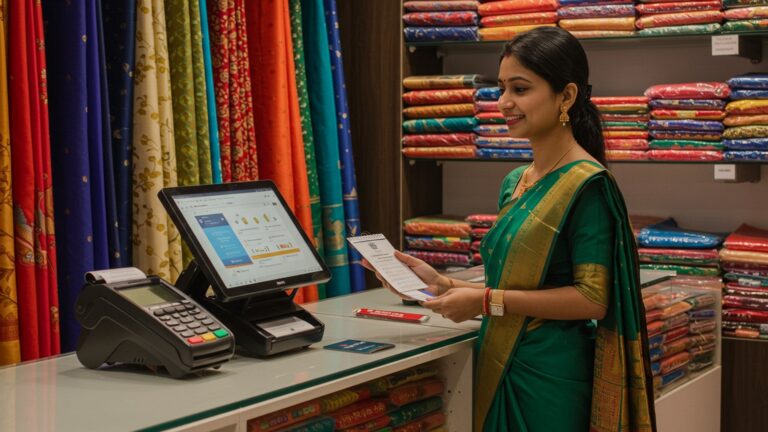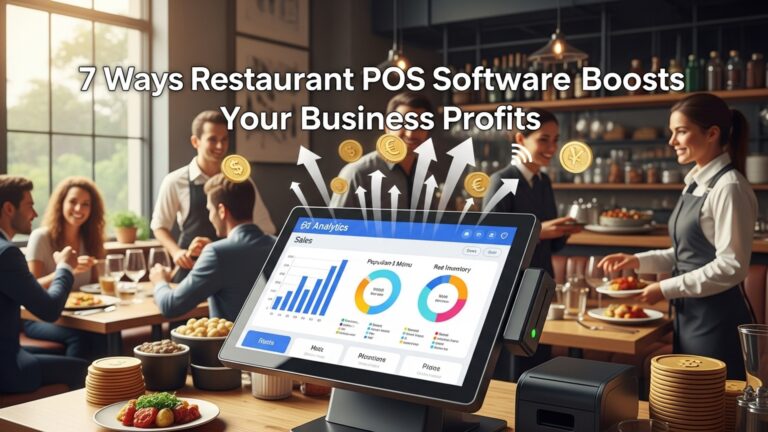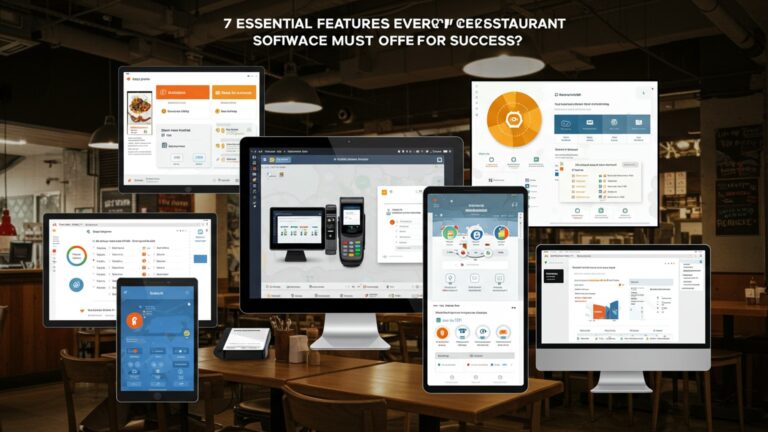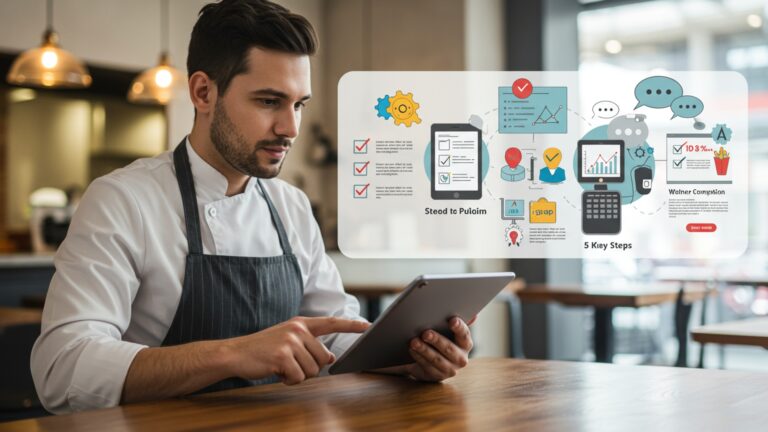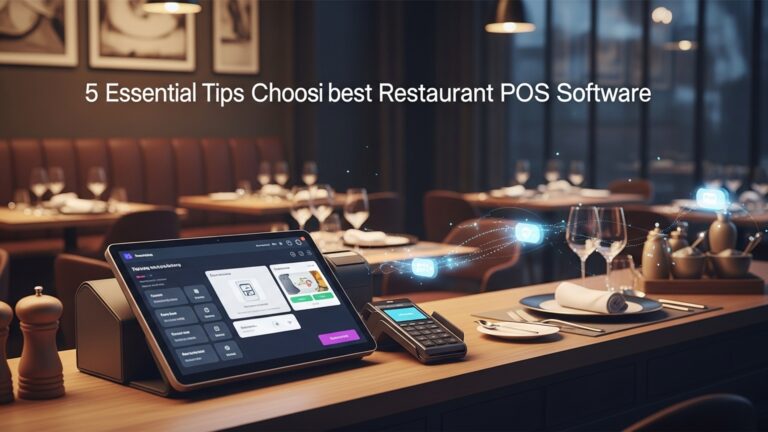How to Leverage Restaurant POS Features for Better Customer Experience
In today’s competitive culinary landscape, customer expectations extend far beyond just good food; diners demand seamless, personalized. efficient experiences. Modern Restaurant POS features have evolved from simple transaction processors into powerful, integrated platforms that are pivotal for meeting these demands. Consider how contactless ordering via QR codes, AI-driven personalized recommendations. real-time loyalty program integration elevate the customer journey from initial reservation to post-meal feedback. Leveraging these advanced functionalities allows restaurants to streamline operations, anticipate guest needs through data analytics. ultimately cultivate a more memorable and engaging dining experience, fostering lasting loyalty in an era defined by digital convenience.
Understanding the Modern Restaurant POS System
At its core, a Point-of-Sale (POS) system in a restaurant is far more than just a cash register. It’s a comprehensive digital hub that manages sales transactions, tracks inventory. simplifies daily operations. Historically, POS systems were primarily transactional. But, modern Restaurant POS features have evolved dramatically, transforming into powerful tools designed to optimize every facet of a restaurant’s business, with a significant emphasis on enhancing the customer journey. Think of it as the central nervous system of your dining establishment, orchestrating everything from order taking to payment processing and even customer feedback.
A typical POS system today comprises both hardware and software. The hardware might include touch-screen terminals, kitchen display systems (KDS), receipt printers. credit card readers. The software, on the other hand, is the brains of the operation, providing the interface for staff, managing data. integrating with other essential applications. Understanding these fundamental components is the first step in unlocking the full potential of Restaurant POS features for a superior customer experience.
Streamlining the Ordering Process for Seamless Service
One of the most immediate ways advanced Restaurant POS features impact customer experience is by revolutionizing the ordering process. Gone are the days of handwritten tickets and miscommunicated orders. Modern POS systems ensure accuracy and speed, which are crucial for customer satisfaction.
- Digital Menus and Customization: Waitstaff can take orders directly on handheld devices or tablets, instantly sending them to the kitchen or bar. This reduces errors, speeds up service. allows for extensive customization requests (e. g. , “no onions,” “extra sauce”) to be accurately relayed. Customers appreciate the precision and the confidence that their specific dietary needs or preferences will be met. For instance, a server taking an order for a customer with a nut allergy can input this directly into the POS. the kitchen will receive a clear alert, preventing potentially dangerous cross-contamination.
- Kitchen Display Systems (KDS): Integrated KDS replace paper tickets, displaying orders digitally in the kitchen. This ensures orders are prepared efficiently and in the correct sequence, minimizing wait times and ensuring food quality. For example, a busy pizza restaurant using a KDS can manage multiple orders simultaneously, ensuring each pizza is cooked perfectly and delivered hot, leading to happier customers who receive their food promptly and correctly.
- Self-Ordering Kiosks: For fast-casual or quick-service restaurants, self-ordering kiosks are a game-changer. Customers can browse menus, customize their orders. pay without waiting in line. This empowers customers, gives them control. significantly reduces perceived wait times. Think of the efficiency at a modern McDonald’s or Panera Bread, where customers can quickly place complex orders tailored to their preferences without human intervention.
These Restaurant POS features collectively create a smoother, faster. more accurate ordering experience, directly contributing to a positive impression and increased likelihood of repeat business.
Optimizing Table Management and Reservations
Effective table management is vital for a smooth dining experience, especially during peak hours. Advanced Restaurant POS features offer sophisticated solutions that turn potential chaos into organized efficiency.
- Real-time Table Status: POS systems provide a visual layout of the restaurant, showing which tables are occupied, vacant, or about to become available. This allows hosts to seat customers quickly and efficiently, minimizing wait times and avoiding overbooking. Imagine a customer walking into a bustling restaurant; a host with an accurate POS system can immediately tell them the exact wait time or guide them to an available table, preventing frustration and ensuring a positive first impression.
- Integrated Reservation Systems: Many modern POS systems include or integrate with online reservation platforms. Customers can book tables days or weeks in advance, receiving automated confirmations and reminders. This convenience is a significant positive for customers and helps restaurants manage their capacity effectively. A study by OpenTable highlighted that 47% of diners prefer to book online, underscoring the importance of this feature for meeting customer expectations in today’s digital landscape.
- Waitlist Management: When reservations aren’t possible, intelligent waitlist management features ensure fairness and transparency. Customers can be added to a digital waitlist, receive SMS notifications when their table is ready. even track their position in the queue. This reduces the need for customers to physically wait in a crowded lobby, enhancing their comfort and overall experience by providing clear communication.
These specific Restaurant POS features directly address common pain points associated with dining out, transforming potential frustrations into seamless interactions.
Enhancing Payment Processing and Flexibility
The checkout experience is the final touchpoint in a customer’s dining journey. it should be as smooth and convenient as possible. Modern Restaurant POS features offer a variety of payment options that cater to diverse customer preferences.
- Multiple Payment Options: Beyond traditional credit and debit cards, POS systems now support mobile payments (Apple Pay, Google Pay), contactless payments. even QR code payments. Offering these diverse options caters to customer convenience and perceived security. Customers appreciate the flexibility to pay But they prefer, making the transaction quick and hassle-free.
- Table-Side Payments: Empowering servers with mobile POS devices allows them to process payments directly at the table. This eliminates the need for customers to wait for the check, for the server to run the card. then return with a receipt. It’s faster, more secure (cards never leave the customer’s sight). significantly improves the efficiency of the checkout process. A case study from a popular chain, The Cheesecake Factory, noted how table-side payment terminals improved table turnover and customer satisfaction by speeding up the final stage of the dining experience.
- Split Bill Functionality: A common request, especially for larger groups, is to split the bill. Advanced Restaurant POS features make this incredibly easy, allowing servers to divide checks by item, by equal amounts, or by specific customer requests, all without complex manual calculations. This avoids awkward situations and ensures a positive end to the meal, reflecting positively on the restaurant’s attentiveness to customer needs.
By providing flexibility and convenience in payment, these Restaurant POS features leave a lasting positive impression, encouraging repeat visits.
Leveraging Customer Relationship Management (CRM) for Personalization
True customer experience goes beyond a single transaction; it’s about building relationships. Modern Restaurant POS features integrate powerful CRM capabilities that enable restaurants to interpret and cater to individual customer preferences, fostering loyalty and personalization.
- Customer Profiles and Purchase History: A POS system can store valuable customer data, including contact data, past orders, dietary restrictions, preferred seating. even special occasions. For example, if a regular customer always orders the same wine and appetizer, a server, prompted by the POS, can proactively suggest it on their next visit, creating a feeling of being recognized and valued.
- Personalized Recommendations: Using purchase history, the POS can help staff make informed, personalized recommendations. “Welcome back, Sarah! Would you like your usual latte with almond milk today?” This level of recognition makes customers feel valued and understood, enhancing their emotional connection to the establishment.
- Feedback Integration: Some POS systems integrate with feedback platforms, allowing customers to easily provide input on their dining experience. This feedback can then be tied back to their customer profile, enabling targeted improvements and demonstrating that the restaurant values their opinion, which is crucial for continuous improvement and customer retention.
These advanced Restaurant POS features transform generic service into a highly personalized interaction, building stronger bonds between the customer and the establishment.
Seamless Online Ordering and Delivery Management
In today’s digital age, online ordering and delivery are non-negotiable for many customers. Integrated Restaurant POS features are crucial for managing these channels efficiently, extending the customer experience beyond the physical dining room.
- Unified Order Management: A single POS system can consolidate orders from various channels – in-house, website, third-party delivery apps (e. g. , DoorDash, Uber Eats). This prevents manual data entry errors, simplifies kitchen workflows. ensures consistent pricing and menu availability across all platforms. Without a unified system, managing multiple tablets for different delivery services can lead to significant operational headaches and customer dissatisfaction due to missed or delayed orders.
- Real-time Order Tracking: Customers expect transparency. Many POS-integrated online ordering platforms offer real-time order tracking, allowing customers to see the status of their meal from preparation to delivery. This reduces anxiety and provides a sense of control, much like tracking a package online, significantly enhancing the off-premise dining experience.
- Delivery Driver Management: For restaurants with their own delivery fleet, POS systems can help assign drivers, optimize routes. track delivery times, ensuring timely and efficient service. This is vital for maintaining food quality and meeting customer expectations for prompt delivery.
By effectively managing these external touchpoints, Restaurant POS features ensure that the convenience of online ordering translates into a consistently positive customer experience, regardless of where they choose to enjoy their meal.
Implementing Loyalty Programs and Promotions
Loyalty programs are proven drivers of repeat business. modern Restaurant POS features make them incredibly easy to implement and manage, directly contributing to a better customer experience by rewarding patronage.
- Automated Loyalty Tracking: Customers can sign up for loyalty programs directly through the POS. their points or rewards are automatically tracked with each purchase. This eliminates the need for physical punch cards, which are often forgotten or lost, making the program more accessible and appealing.
- Targeted Promotions: Based on customer purchase history and preferences stored in the POS-integrated CRM, restaurants can send personalized promotions (e. g. , “10% off your favorite pasta dish this week,” “Free dessert on your birthday”). This makes customers feel special and encourages them to return. For example, a coffee shop might use their POS data to identify customers who frequently purchase a specific pastry and then send them a targeted offer for a free pastry with their next coffee, driving incremental sales and loyalty.
- Gift Card Management: POS systems seamlessly handle the sale, redemption. tracking of gift cards. This offers customers a convenient gifting option and ensures smooth transactions when gift cards are used, adding another layer of customer convenience and revenue opportunity.
These Restaurant POS features not only drive loyalty but also enhance the customer experience by providing tangible benefits and making them feel appreciated.
Leveraging Data Analytics for Continuous Improvement
Perhaps one of the most powerful, yet often underutilized, Restaurant POS features for customer experience improvement is its robust data analytics capability. A POS system collects a vast amount of data that, when analyzed, can reveal crucial insights into customer behavior and operational efficiency.
- Identifying Popular Items: POS data can clearly show which menu items are selling well and which are not. This allows restaurants to optimize their menu, focusing on customer favorites and potentially removing unpopular items, thus ensuring a more satisfying menu offering that aligns with customer preferences.
- Peak Hour Analysis: Understanding peak dining times helps with staffing decisions, ensuring adequate service during busy periods to minimize wait times and maintain service quality. For example, a restaurant realizing its lunch rush is consistently busiest between 12:30 PM and 1:30 PM can schedule more servers during that specific hour, directly improving service speed.
- Customer Segmentation: By analyzing purchase patterns, restaurants can segment their customer base and tailor marketing efforts or service approaches to different groups. For instance, identifying your most frequent lunch customers versus your weekend dinner crowd allows for targeted communications and offers.
- Server Performance: Some advanced POS systems can track server performance, such as average check size or table turnover rates. This data can be used for training and coaching, leading to improved service quality across the board by identifying areas for individual and team growth.
By continuously analyzing these insights, restaurants can proactively refine their operations and service strategies, ensuring that every decision is data-driven and ultimately leads to a better customer experience. This proactive approach to using Restaurant POS features for analysis is what distinguishes good service from exceptional service.
Comparison: Traditional vs. Modern POS Features for CX
To fully appreciate the impact of modern Restaurant POS features, it’s helpful to compare them against the capabilities of older, more traditional systems. This table highlights how the evolution of POS technology directly translates into an improved customer journey.
| Feature Area | Traditional POS System | Modern POS System |
|---|---|---|
| Order Taking | Manual entry, handwritten tickets, potential for errors, slower. | Digital order taking (handheld devices), direct kitchen integration, high accuracy, fast, supports customization. |
| Table Management | Manual charts, verbal communication, prone to errors, longer wait times. | Real-time visual layout, integrated reservations, waitlist management, SMS alerts, optimized seating. |
| Payment Processing | Limited options (cash, main credit cards), fixed terminals, wait for check. | Multiple options (mobile, contactless, QR), table-side payments, easy bill splitting, enhanced security. |
| Customer Relationship | Minimal or no customer data tracking, generic service, no personalized recognition. | Detailed customer profiles, purchase history, personalized recommendations, feedback integration, loyalty building. |
| Online & Delivery | Separate systems, manual order entry, potential for errors and delays, disjointed experience. | Unified order management, real-time tracking, delivery driver management, seamless multi-channel experience. |
| Loyalty Programs | Manual punch cards, limited tracking, generic promotions, high friction. | Automated tracking, personalized rewards, targeted promotions, gift card management, effortless engagement. |
| Data Analytics | Basic sales reports, limited insights into customer behavior or operational efficiency. | In-depth sales analytics, peak hour analysis, customer segmentation, server performance metrics for continuous improvement. |
As evident, modern Restaurant POS features move beyond mere transaction processing to become strategic tools for cultivating an exceptional and memorable customer experience, driving both satisfaction and loyalty.
Conclusion
Ultimately, your restaurant’s POS system is far more than a mere transaction processing tool; it’s a dynamic hub for crafting exceptional customer experiences. By actively leveraging features like integrated CRM, you can move beyond generic service to truly personalized interactions, perhaps remembering a customer’s favorite coffee order or their dietary preferences before they even voice them. I’ve personally found that the restaurants which empower their staff with instant access to such insights through mobile POS devices not only streamline operations. also foster a genuine connection, transforming a simple meal into a memorable occasion. Embrace the current trend towards data-driven personalization and seamless loyalty program integration directly through your POS. This not only rewards your most dedicated patrons instantly but also provides invaluable insights for future marketing efforts, helping you anticipate needs and exceed expectations. Think of it as investing in an invisible concierge service for every guest. The true power lies in how these digital tools enable your human team to deliver authentic hospitality, creating a positive ripple effect that extends from the first interaction to their next visit, solidifying loyalty and driving repeat business. For further insights into elevating service, consider exploring how innovative tech is shaping the future of dining.
More Articles
Optimizing Table Turnover with Digital Tools
Crafting Engaging Restaurant Loyalty Programs
The Role of AI in Modern Restaurant Operations
Mastering Online Ordering Platforms for Growth
Staff Training for Tech-Savvy Service Excellence
FAQs
How can my POS speed up service and make customers happier?
A good POS lets your staff take orders digitally right at the table, sending them straight to the kitchen. This cuts down on errors, speeds up food prep with kitchen display systems (KDS). makes checkout quicker with accurate, on-the-spot billing. Faster service means happier customers!
Can a POS help me remember customer preferences for a more personal touch?
Absolutely! Many POS systems can store customer profiles, noting things like their favorite dish, dietary restrictions, or even their birthday. This allows you to offer personalized recommendations, remember special requests. even run targeted loyalty programs, making guests feel truly valued.
What features prevent wrong orders and improve accuracy?
Digital order entry directly from the server’s device or self-service kiosks drastically reduces manual errors. Clear modifiers (e. g. , “no onions,” “extra sauce”) ensure the kitchen gets precise instructions. Also, Kitchen Display Systems (KDS) eliminate handwritten tickets, so there’s no misreading orders.
How does a modern POS make paying easier for guests?
A solid POS offers a ton of payment flexibility. Customers can pay with credit cards, mobile wallets, or even split bills effortlessly. Faster processing times and the ability to pay at the table or even through online portals reduce wait times and make the checkout experience smooth and convenient.
My restaurant gets lots of special requests and allergy concerns. Can a POS help manage that?
Definitely. POS systems are great for handling special requests. You can easily add detailed notes to orders, flag allergy alerts directly to the kitchen staff via the KDS. even customize menu items on the fly. This ensures everyone’s needs are met safely and accurately.
Beyond just taking orders, how can a POS build customer loyalty?
Many POS platforms integrate loyalty programs. You can track customer visits, reward points. offer exclusive discounts or freebies. Some even allow for direct feedback collection after a visit, showing customers you care about their experience and encouraging them to return.
What about handling online and in-person orders without a headache?
A truly effective POS integrates all your ordering channels – dine-in, takeout, delivery. online. This means every order, no matter where it comes from, funnels into one system. It prevents missed orders, reduces confusion in the kitchen. ensures a consistent, timely experience for all customers.

